In this post I share how I healed my Keratosis Pilaris (KP) with diet changes including going gluten free, dairy free, increasing omega 3 intake, eliminating processed foods, and increasing fat soluble vitamin intake.
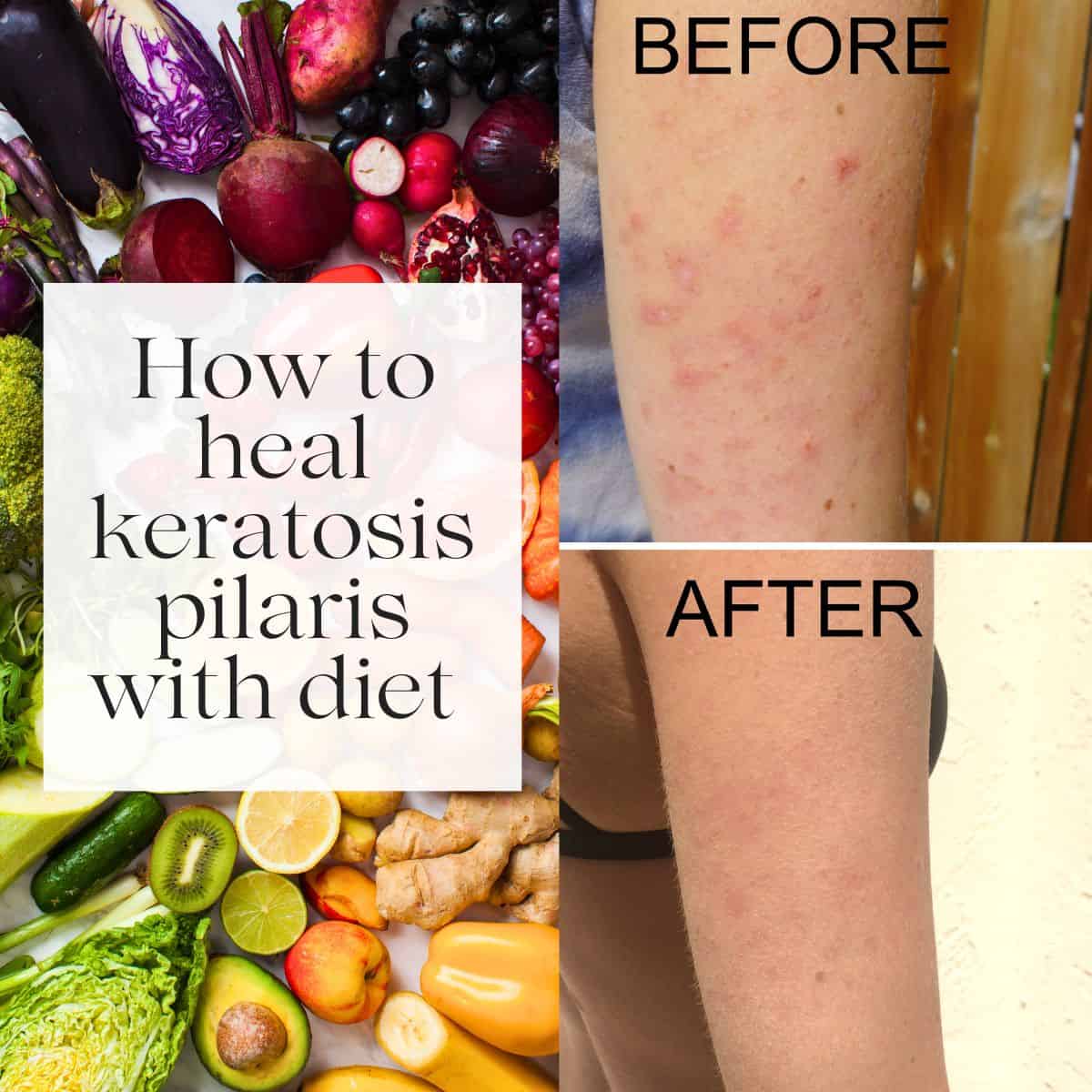
Disclaimer: this post is not to be taken as medical advice and should be used for informational purposes only. Always discuss any nutritional or diet changes with your doctor or other health care practitioners.
Chances are if you made it here you have tried other things to try and heal your keratosis pilaris (KP) and are not having success. Well I'm glad you're here. Since I shared my post "How I Healed My Keratosis Pilaris (KP) Naturally" it has quickly become the most popular post on the blog. In that post I shared the topical treatments that I used to help my KP, but there are also a number of diet changes that I made that I also think helped, and that will be the focus of today's post.
I believe that food is a form of medicine. What we feed our bodies is so important. If you aren't eating well, your health will never be at its best. Changing my diet was a crucial factor in helping my body heal from many chronic health issues including diarrhea, bloating, acne, headaches, and Keratosis Pilaris.
I think there are many reasons why food can impact our skin, including through inflammation, nutrient deficiencies, food sensitivities, allergies, and hormonal imbalances. As well, the importance of the gut microbiome is becoming increasingly recognized as playing an important role in skin health. If your gut bacteria is imbalanced it can lead to various skin conditions including acne, rosacea and more. So with that in mind let's get into the diet changes that I found helpful for keratosis pilaris.
Table of Contents
What is keratosis pilaris?
Keratosis pilaris, which is often called "chicken skin" is a skin condition that causes small, rough bumps on the skin, most commonly on the back of arms. Keratosis pilaris is harmless and does not require treatment, although for cosmetic reasons many people do try and treat it.
The most common treatments for keratosis pilaris focus on external treatments like exfoliation, creams and topical ointments, but many people do report improvements in their KP when they change their diet. I used to have keratosis pilaris and often picked at it which made it look even worse (see the photo below). However, I found that by making dietary changes I was able to heal my KP (which you can see in my before and after photos below). So far there have been no studies published looking at the role of diet in treating KP, so the information in this post is based on my own experience, the experience of my patients and readers, and research that has been done on other skin conditions.
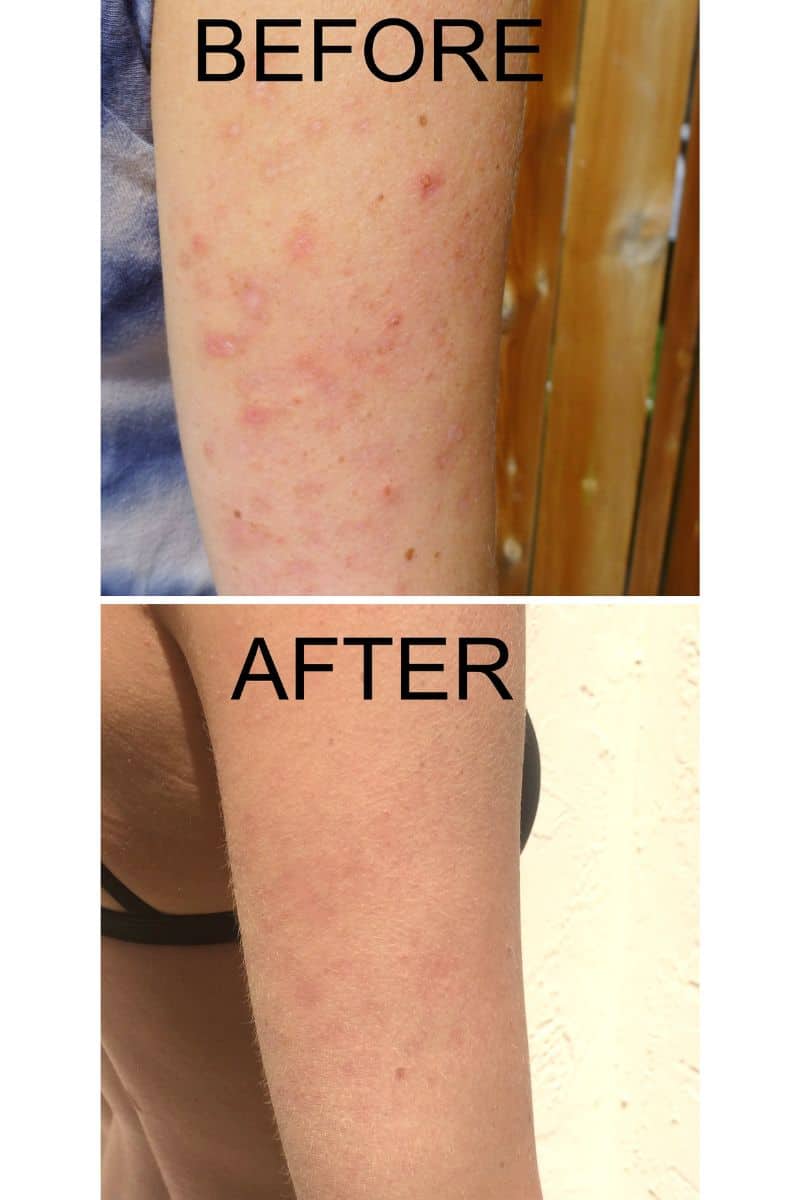
Diet Changes for Keratosis Pilaris:
1. Gluten-free diet
For some people, certain grains, especially those with gluten, can have some negative health effects, and a few reasons why include their high lectin content, the high phytic acid content, the gliadin content, and their high omega-6 content. In some people, these substances can damage the intestinal lining leading to leaky gut syndrome, decreasing your absorption of vitamins and minerals and increasing inflammation.
Leaky gut syndrome (otherwise known as increased intestinal permeability) allows food particles, toxins, bacteria and other foreign particles that should remain in the gut to cross the gut barrier and enter the blood stream. This can lead to systemic inflammation, and in susceptible people, can contribute to the development of different health problems. In my case, when I was struggling with leaky gut, my KP was at its worst. Once I was able to heal my gut my skin also began to heal.
Sensitivities to gluten are also common. Non-celiac gluten sensitivity is a condition which can cause many different health issues, including skin rashes. Other skin problems that have been shown to improve with a gluten-free diet include psoriasis, atopic dermatitis, vitiligo, and palmoplantar pustulosis.
Going gluten-free was one of the best things I did for my health. When my health was at its worst, I did initially follow the paleo diet, which eliminates all grains, but I don't think this is necessary for everyone. If you are going to try a gluten-free diet I would suggest trying it for 2-3 months to see if it makes any difference for you.
2. Increase omega-3 fatty acid intake
Omega-3-fatty acids are important for skin health. Omega-3 supplementation has been found to help treat acne, psoriasis, eczema, dry skin, and a number of other health conditions. As well, increased omega-3 intake makes you less likely to get a sunburn (how cool is that?).
Unfortunately, modern diets tend to be very unbalanced in essential fatty acid intake. A healthy, balanced diet should consist of roughly one to four times more omega-6 fatty acids than omega-3 fatty acids, but the typical North American diet tends to contain 11 to 30 times more omega-6 fatty acids than omega-3.
Even foods that traditionally were not very high in omega-6 fatty acids now are because of the processing and methods use to produce them. For example, cows raised on grass produce meat with an omega-6 to omega-3 ratio of 1-4:1. However, cows fed grains (as they are on most modern farms or factory farms) produce meat with an omega- 6 to omega-3 ratio of 8-13:1. This excessive intake of omega-6 is felt to increase inflammation in the body and contribute to various health issues.
Unfortunately, like diet, no studies have looked at the role of omega 3 and 6 in keratosis pilaris development, or treatment, but myself, as well as others, have seen an improvement when we increased our omega-3 intake.
Here are a few easy ways to increase the omega-3 content and decrease the omega-6 content of your diet:
- Eat grass fed and grass finished beef - besides being high in omega-3, grass fed beef is also a really great source of vitamins and minerals.
- Use less crop oils (also referred to as vegetable oils) and switch to oils that are higher in omega 3 such as olive oil and avocado oil.
- Eat wild (not farmed) fish including salmon, herring, sardines, anchovies, trout and oysters.
- Eat pasture raised eggs.
If you are not able to eat the things I mentioned, you may need to supplement your diet with omega-3 or fish oil.
3. Eliminate dairy
As I mentioned previously, in some people skin issues can be linked to food sensitivities or allergies, and sensitivities to dairy are common. More specifically, intolerance to casein (a protein found in dairy) and lactose found in dairy can be a problem for some people.
Now, I also realize that there are significant health benefits related to consuming dairy products, so not everyone will need to eliminate dairy from their diet. If you find that you are sensitive to dairy, eliminating it from your diet for 2-3 months to see if you notice any improvement in your skin might be worth a try. Of course if you have a dairy allergy or are lactose intolerant you should also not consume dairy products.
4. Remove processed sugars and processed food
Processed or refined sugars can cause skin issues. A diet that is high in high glycemic foods and refined sugars has been linked to the development of acne, but so far no studies have been published regarding sugar intake and keratosis pilaris.
As well, the modern North American diet also tends to be high in processed foods. Processed food intake has been linked to increased rates of cancer, heart disease, type 2 diabetes and many other health conditions. There have been few studies looking at the role of processed foods on skin health, but one study did show an increased rate of atopic dermatitis in people eating a diet high in processed food.
In order to improve our overall health we should all aim to limit our intake of processed foods and processes sugars, and if your KP improves as well that would just be an added bonus.
5. Increase fat soluble vitamin intake
The fat soluble vitamins, A, D, E, and K are all very important for healthy skin, and unfortunately, based on our modern diets and lifestyles, many people are deficient in some or all of these vitamins.
Vitamin A deficiency has been shown to increase the risk skin infections and inflammatory skin conditions and is also known to cause Phrynoderma, which is a skin condition involving keratin, and vitamin A supplementation has been shown to treat this disorder. Of note, too much vitamin A can also cause skin issues, so it is important not to over-consume or over-supplement with vitamin A.
Vitamin D deficiency has been linked to many different health problems including autoimmune diseases, heart disease, diabetes etc. There is also some evidence that vitamin D deficiency is involved in acne, and while there have been no studies looking at vitamin D deficiency and keratosis pilaris directly, many people do report that their KP improves if their vitamin D deficiency is corrected.
Vitamin E has been shown to help treat atopic dermatitis and has been shown to be protective against skin damage from the sun by acting as an antioxidant.
There are fewer studies looking at vitamin K when it comes to skin health, but there is evidence to suggest that topical vitamin K can help the skin heal faster after medical procedures.
Here is a list of foods that are high in fat soluble vitamins to help you increase your intake:
- Vitamin A: liver from pasture raised animals, and wild fish.
- Vitamin D: fresh, oily fish, including salmon, sardines and oysters. Of note, one of the best sources of vitamin D is sun exposure (but too much sun exposure is harmful to our skin so please keep this in mind).
- Vitamin E: almonds, hazelnuts, flax seed oil, and green leafy vegetables.
- Vitamin K: cooked kale, raw swiss chard, dandelion greens, raw radicchio and spinach.
Now, another quick word about vitamin D. Most people live in places where you cannot obtain enough vitamin D through sun exposure alone so you will likely need to supplement with vitamin D. You can have your level checked through your family physician to determine how much you need to take, and ensure that you are not taking too much (as taking too much vitamin D can also be dangerous).
In summary:
To date there have been no studies examining the role of diet and nutrition in relation to keratosis pilaris. However, some people find that focusing on a healthy, anti-inflammatory diet that is low in refined sugars and processed food can be helpful. A gluten free diet may also help, and making sure that you get enough omega-3 fatty acids and fat soluble vitamins has been shown to be essential for overall skin health.
One important thing to note is that if you have a child with keratosis pilaris, I would not recommend making any dramatic changes to their diet (such as going gluten free) unless recommended by their own physician or health care provider. Kids are more susceptible to vitamin and mineral deficiencies and so it is generally not recommended that they be given restrictive diets, unless it's under the guidance or recommendation of a health care provider.
I hope you found this helpful! If you have any questions please let me know.
And if you are interested in the skincare products and methods that I recommend for healing keratosis pilaris I have a full post on this topic as well.
Be sure to download my full guide, How to Heal Keratosis Pilaris from the inside out by leaving your email below:
Other health info you will be interested in:
Keratosis Pilaris diet FAQs:
There have been no studies done to answer this question. I personally found that when I increased my fat soluble vitamin intake that my KP improved.
There have been no studies done to examine whether certain foods cause or contribute to Keratosis Pilaris but I personally found that gluten, dairy, and refined sugars, all contributed to mine, and removing those foods allowed me to heal.
Our expertise:
Dr. Erin Carter, MD, FRCPC, is a physician with board certifications in internal medicine and rheumatology. She is passionate about preventative healthcare including nutrition, environmental health and low toxicity living.
Disclaimer: The statements made on this website have not been approved by the Food and Drug Administration or Health Canada. The information is not intended to diagnose, treat, cure, or prevent disease. You assume full responsibility for how you use this information. Always consult with your physician or other health professionals before making any diet or lifestyle changes.

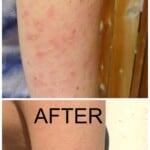
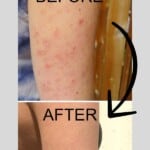
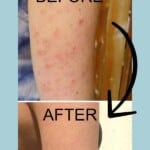




Lissa
The first picture is of your left arm and the second is of your right arm. Do you have a before and after of the same arm?
Erin Carter
Hi Lisa! Both photos are of my right arm. One is just closer up than the other. I have a left arm photo in my other post about KP but not this post:
https://www.pureandsimplenourishment.com/how-i-healed-my-keratosis-pilaris-part1/
Hanna
Does limiting protein help reduce Kp?
Erin Carter
Not in my experience. Protein is important for skin health.
Jake
Why only full fat milk? As that's more processed than skimmed milk I would rather drink fat-free.
Erin Carter
Hey Jake! You've got it backwards. Milk comes from the animal in its full fat state and then undergoes processing to remove fat. It's actually the fat free or low fat options that are the more processed versions. The processing also removes important vitamins and minerals too. That's why the full fat is actually a healthier option if you choose to consume dairy.
Erin Carter
Hey Jasanna. I'm not too picky when it comes to my vitamin D brand. It's hard to find ones in 5000 IU in Canada so I often buy them from vitacost and get them shipped here. I just make sure the capsule ingredients are SCD legal (since I still follow that diet as much as possible) and that there are no fillers.
Jasanna Czellar
What kind of Vit D do you take? Thanks!
GlassesShop
Nice article, thank you for the sharing
DV
Grains done, sugar (easier after withdrawL), but cheese in my omlette or Ceasar salad......gulp, snivel......I will be the one hoarding the pastured eggs!!
Erin Carter
Thanks DV! Dairy can be a hard one to give up for sure! Between that and grains it does eliminate a lot of foods but you do get used to it after a while 🙂
DV
Excellent post! Now I just need to ake the final commitment to breaking up with dairy....